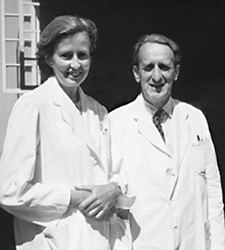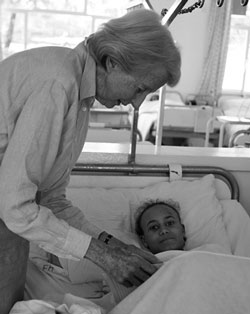Tadias Magazine
By Tseday Alehegn
Updated: Tuesday, October 13, 2009
New York (TADIAS) – “It is the oldest medical cause in the world. There is currency dug out of pyramids containing images of fistula, yet in the 21st century it is the most neglected cause,” Dr. Catherine Hamlin tells us. While the last American hospital for fistula patients closed its doors in 1895, the first one of its kind opened almost 8 decades later in Ethiopia. Since its inception in 1974, the Addis Ababa Fistula Hospital founded by Dr. Reginald and Catherine Hamlin has treated over 25,000 women, the majority of whom have been cured and have returned to their villages to live healthy, normal lives.
Obstetric fistula is a childbirth injury that affects one out of every 12 women in Africa and approximately three million women worldwide. In developing nations where access to hospitals in remote areas are difficult to find, young women suffer from obstructive labor which can otherwise be successfully alleviated with adequate medical support. Unassisted labor in such conditions may lead to bladder, vaginal, and rectum injuries that incapacitate and stigmatize these women. Most patients are ousted from their homes and isolated from their communities.
Until her journey to Ethiopia, Dr. Catherine Hamlin, a gynecologist and a native of Australia, noted “we had read in our textbooks about obstetric fistula but had never seen one.” After arriving in Ethiopia with her husband, she was warned by a colleague “the fistula patients will break your heart.”
Site Map
“When we first arrived we were rather taken with the country because we saw our eucalyptus trees,” Dr. Catherine Hamlin recounts. “I come from Australia and I felt very much at home straight away because the scenery seemed very familiar to us. Of course the people were different but we got a really warm welcome so we didn’t really have culture shock.” She described their professional environment as one were they “worked in a hospital with other physicians who were trained in Beirut and London.” However as the only two gynecologists on staff they found it difficult to get away even for a weekend. For the first 10 years of their work with the hospital Reginald and Catherine took weekend breaks at alternate times so as to have at least one gynecologist on call at all times, barely managing to take a month off each year to travel to the coast in Kenya. It is during their time at Princess Tsehai hospital that they first encountered fistula patients.

Dr. Reginald and Catherine Hamlin.
Recounting their mutual desire to open a hospital primarily dedicated to the fistula patients, Dr. Catherine Hamlin emphasized their keen focus on raising money for this cause. Both Reginald and Catherine worked arduously to create a place that would pay more attention to the large number of women who lived in tremendous hardship as a result of their childbirth injuries. Since operations to cure fistula were not considered life-saving operations, few operating tables and beds were available for such patients at Princess Tsehai Hospital. Fistula patients were also not welcome and were despised by other patients and it wasn’t long before Reginald and Catherine decided to build a hospital designed to help these women, some of whom traveled hundreds of miles to seek treatment.
Speaking of her late husband, Catherine noted, “When he saw the first fistula patient he was really overwhelmed. He devoted his whole life to raising money to help these women. He was a compassionate man and if he took on anything he would take it in with his whole heart and soul. He worked day and night to build the hospital.” The dream was realized in 1974 and soon the Addis Ababa Fistula Hospital received 1 to 10 fistula patients at its doorstep on a daily basis. Women who heard about the possibility of being cured traveled to the Capital from distant villages across the country. Today the Fistula Hospital treats approximately 1,500 women annually. Five surgeons conduct surgeries three times a week and work alongside Dr. Catherine Hamlin in an operating theatre equipped with four operating tables. The majority of operations become success stories and the women who are cured happily return to their homes.
A very small percentage of women (three to four annually) who arrive at the hospital, however, have irreparable damage and cannot be completely cured. For these women a 60-acre plot of land has been set aside as a place for them to stay. This compound is known as ‘Desta Mender’ – Village of Joy. Describing Desta Mender, Dr. Hamlin states, “women who are unable to resume normal lives in their villages are allowed to reside permanently in Desta Mender. Since there isn’t a lot of beds available at the hospital, those young girls who need to be strengthened prior to their operations are also allowed to stay temporarily at Desta Mender prior to their scheduled surgeries. It is called Desta Mender because it is a place of joy and it is designed for the women to be able to live lives similar to the ones they had in their villages.” Women who are unable to have surgery right away are able to undergo physical therapy and recuperate from their long walking travels at Desta Mender while those who cannot return to their villages even after surgeries are able to live in their new homes enjoying their work on the farm land and producing their own food.

Dr. Hamlin with a patient (fistulafoundation).
Few individuals have dedicated a lifetime for a cause as noble as this. Asked what her greatest satisfaction has been in this endeavor, Dr. Catherine Hamlin responds “It is in knowing that I am working somewhere where God has placed me to work. And I think that we gained more by living there and working with these women than we lost by leaving our own countries.” She fondly speaks of her late husband and his infinite compassion for the fistula patients. “He loved the whole of Ethiopian society and when he was dying in England it was his final wish to return and be buried in Ethiopia,” she states.
Dr. Catherine Hamlin equally enthuses about her ‘home away from home’, emphasizing the joy she feels in seeing a happy, cured patient and her continued enjoyment of the landscape of Ethiopia. Amidst her busy schedule she has found time in the early hours of dawn to write down the story of her life in her book ‘The Hospital by the River’, which was a bestseller in Australia. Her humble personality is evident as she replies to our inquiries about her past nomination for the Nobel Peace Prize by saying she didn’t know about it. Indeed along with being nominated for the Nobel Peace Prize in 1999 she has also been awarded the Gold Medal of Merit by Pope John Paul in 1987, and an Honorary Gold Medal from the Royal College of Surgeons in England in 1989. In 2003 she was nominated as an Honorary Fellow of the American College of Surgeons.
Her message to Ethiopians in the Diaspora is clear and simple. “You can help spread the word,” she says. “There are approximately eight to nine thousand women annually who suffer from fistula in Ethiopia. We are currently working on building five regional hospitals and have received funding for two. We need doctors to come back to Ethiopia to help us in our work. There is no money in it but there is enormous joy to the doctors and nurses treating and curing these patients.” She challenges us to help raise awareness and the financial assistance needed to keep this work going. In light of her 50-year dedication to the eradication of fistula, answering her appeal is the very least that any one of us can do.
Tadias Magazine congratulates Dr. Catherine Hamlin on her well deserved recognition as the co-winner of the 2009 Right Livelihood Award!
—
Interview with Dr. Hamlin conducted by Mahlet Teklemariam and Emmanuel Mekuria.